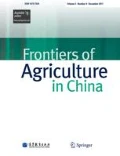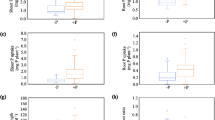Abstract
In the present study, 156 soybean genotypes mainly from the Hebei growing-area were identified for their low phosphorus starvation tolerance. The results showed that the relative values (value of dry wt. in zero soil P/value of dry wt. in adequate soil P) of shoot dry weight and root dry weight of all soybean varieties, at the phosphorus concentration of 0 mmol·L−1 and 1.0 mmol·L−1 in supplied solution, offered a quick and reliable method to identify and classify genotypes for phosphorus starvation tolerance. We describe three classes: tolerant, moderate and sensitive P starvation groups which had 29, 59, and 68 cultivars, respectively. Eight varieties, Ji-dou11, Lü75, Hei-da-li, Zhong-huang15, Zhe98-14, Da-mao-jiao, Dahuang-dou and Zha-lai-te-qi were screened out for their high tolerance to phosphorus deficiency under zero soil phosphorus conditions. In addition, the relationships between soybean phosphorus starvation tolerance and seed phosphorus content, root morphology, rhizosphere acidification are also discussed.
Similar content being viewed by others
References
Cao L M, Pan X H (2000). Screening and identification of rice (Oryza sativa L.) genotypes on the tolerance to low phosphorus environment. Journal of Jiangxi Agricultural University, 22: 162–168 (in Chinese)
Davies T G E, Ying J, Xu Q, Li Z S, Li J, Gordon-Weeks R (2002). Expression analysis of putative high-affinity phosphate transporters in Chinese winter wheats. Plant Cell Environ, 25(10): 1325–1339
Ding H, Cai G X, Jiang X Y, Li S X (1999). Tolerance changes of soybean cultivars with different low phosphorus tolerance on two types of soil. Chinese Journal of Oil Crop Science, 21(3): 56–60 (in Chinese)
Ding H, Guo Q Y, Li Z Y (1998). Effect of phosphorus on grain yield and quality in soybean cultivars. Chinese Journal of Oil Crop Science, 20(2): 66–70 (in Chinese)
Ding Y C, Chen M C, Cheng B, Li L J, Li D Y (2005). Phosphorous uptakes and use s of different soybean varieties. Acta Botanica Boreali-Occidentalia Sinica, 25(9): 1791–1797 (in Chinese)
Ding Y C, Chen M C, Cheng B, Li L J, Zhang H S (2006). The selection of spring soybean genotypes with high phosphorus efficiency in Northern China. Plant Nutrition and Fertilizer Science, 12(4): 597–600 (in Chinese)
Gill H S, Singh A, Sethi S K, Behl R K (2004). Phosphorus uptake and use efficiency in different varieties of bread wheat (Triticum aestivum L). Arch Agron Soil Sci, 50(6): 563–572
Hammond J P, Broadley M R, White P J (2004). Genetic responses to phosphorus deficiency. Ann Bot (Lond), 94(3): 323–332
Holford I C R (1997). Soil phosphorus: its measurement and its uptake by plants. Aust J Soil Res, 35(2): 227–240
Li J Y, Li Z S, Liu X D, Zhou W, Sun J H, Tong Y P (1995). Technique of wheat breeding for efficiency utilizing soil nutrient elements. Science China Chemistry (Series B), 38: 1313–1320
Li S C, Gong J, Wang J (2003). Screening maize inbred lines seedling for tolerance to low phosphate stress. Journal of Maize Sciences, 11: 85–89 (in Chinese)
Li X H, Chang W S, Liu Y, Wang J H, Zhang C Y (2008). Genetic variability for phosphorus content in seeds of soybean varieties. Journal of Plant Genetic Resources, 9(3): 381–384 (in Chinese)
Li Z G (2004). Screening of Soybeans with High Phosphorus Absorption Efficiency and Their Responses to Different Phosphorus Levels. Dissertation for the Doctoral Degree. Shenyang: Shenyang Agricultural University, 36–37(in Chinese)
Li Z H, Chen D, Cao G J, Wang J (1995). P stress response in the growth and the kinetics of P uptake on difference genotype soybean roots. Journal of Jilin Agricultural University, 17(2): 54–57 (in Chinese)
Liu Y (2005). Identification of Tolerance to Rhizosperical Stresses and Inheretance and OTL Locating of Related Root Traits in Soybean. Dissertation for the Doctoral Degree. Nanjing: Nanjing Agricultural University, 67–68 (in Chinese)
Narang R A, Bruene A, Altmann T (2000). Analysis of phosphate acquisition efficiency in different Arabidopsis accessions. Plant Physiol, 124(4): 1786–1799
Neumann G, Massonneau A, Langlade N, Dinkelaker B, Hengeler C, Romheld V, Martinoia E (2000). Physiological aspects of cluster root function and development in phosphorus deficient white Lupin (Lupinus albus L.). Ann Bot (Lond), 85(6): 909–919
Nian H, Guo Z H, Yu R C, Lu Y G, Huang H (1998). Evaluations for low-P tolerance of soybean cultivars from different geographical origins. Soybean Science, 17(2): 108–114 (in Chinese)
Osborne L D, Rengel Z (2002b). Genotypic differences in wheat for uptake and utilization of P from iron phosphate. Aust J Agric Res, 53: 837–844
Ozturk L, Eker S, Torun B, Cakmak I (2005). Variation in phosphorus efficiency among 73 bread and durum wheat genotypes grown in a phosphorus-deficient calcareous soil. Plant Soil, 269: 69–80
Pan X W, Li W B, Zhang Q Y, Li Y H, Liu M S (2008). Assessment on phosphorus efficiency characteristics of soybean genotypes in phosphorus-deficient soils. Agric Sci China, 7(8): 958–969
Raghothama K G (1999). Phosphate acquisition. Annu Rev Plant Physiol Plant Mol Biol, 50(1): 665–693
Smith FW, Mudge S R, Rae A L, Glassop D (2003). Phosphate transport in plants. Plant Soil, 248(1/2): 71–83
Wang C, Luo D M, Xu Y L, Li Z G, Wurentuya, Sarula (2007). The screening of soybean genotypes with tolerance to phosphorus. Journal of Inner Mongolia University for Nationalities, 22(2): 150–153 (in Chinese)
Wu J J, Zhong P, Liu L J, Liu D S, Lin W G, Dong D J (2008). Evaluation on the low phosphorous tolerance of different soybean genotypes. Soybean Science, 27(6): 983–987 (in Chinese)
Xu Q P, Luo C Y, Liao H, Yan X L, Nian H (2003). Study on the response of soybean varieties to P deficiency. Soybean Science, 22: 108–114 (in Chinese)
Yan X L, Wu P, Ling H Q, Xu G H, Xu F S, Zhang Q F (2006). Plant nutriomics in China: an overview. Annals of Botany, 98: 473–482
Yan X L, Zhang F S (1997). Plant Nutrition Genetics. Beijing: China Agricultural Press, 44–45 (in Chinese)
Yi K K, Wu Z C, Zhou J, Du L M, Guo L B, Wu Y R, Wu P (2005). OsPTF1, a novel transcription factor involved in tolerance to phosphate starvation in rice. Plant Physiol, 138(4): 2087–2096
Author information
Authors and Affiliations
Corresponding author
About this article
Cite this article
Li, X., Gai, J., Chang, W. et al. Identification of phosphorus starvation tolerant soybean (Glycine max) germplasms. Front. Agric. China 4, 272–279 (2010). https://doi.org/10.1007/s11703-010-1009-7
Received:
Accepted:
Published:
Issue Date:
DOI: https://doi.org/10.1007/s11703-010-1009-7




